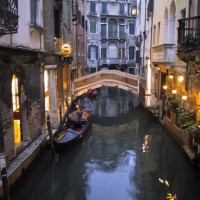Other destinations

PADUA
30 kilometers away
The city of Padua is full of remarkable beauties: the Baptistery from the 12th-century, the Diocesan Museum, housed in the Bishop’s Palace built in 1309, the Piazza dei Signoriand Piazza delle Erbe, known for the fruits and vegetables market, the Town Hall from the 12th-century, the Palazzo della Ragione, built in 1218-19, the medieval cathedral, the Scrovegni Chapel in the garden of the Arena, decorated with 38 frescoes executed by Giotto by 1305, the Romanesque church of Santa Sofia dating back to the Carolingian period, the University called “Bò” one of the oldest in Italy and Europe, the Basilic of Saint Anthony one of the most famous sanctuaries in Italy, built between 1232 and the middle of the 14th-century, the tomb of St. Anthony of Padua, the botanical garden dating back to 1545, one among the oldest in Europe and the richest in Italy.
FERRARA
55 kilometers away
Every corner of Ferrara is so full of charm and history that the city center has been inscribed on the UNESCO World Heritage list. The Estense castle built in the 14th century is characterized by the four corner towers that give to this building its unmistakable profile, and the large moat that protects it from the rest of the city. Also interesting are the 15th century Palazzo dei Diamanti, the St. George’s Cathedral dedicated to the city’s patron saint, with a remarkable Baroque decoration inside, the house where the famous writer Ludovico Ariosto spent a long time and died in 1533, and the many museums housed in historic buildings in the historic center of the city.
VENICE
60 kilometers away
The city of Venice, situated in the heart of a beautiful lagoon, is divided into districts: San Marco, Santa Croce, San Paolo, Dorsoduro, Castello and Cannaregio. The district of San Marco is defined after the Piazza San Marco, famous all over the world. Among many beauties it is recommended to visit: the Archaeological Museum, the Correr Museum, the Palazzo Camerlenghi, the Palazzo Grassi, the Basilica of San Marco (built on the model of the Basilic of the Holy Apostles in Constantinople), the campanile of San Marco, the Ducal Palace. In the district of San Paulo you can visit the Rialto Bridge, Goldoni’s House, the Cà Foscari, seat of the university ot the same name, the Palazzo Albrizzi, the Palazzo Mocenigo, Cà’ Corner and the Church of St. Rocco. Obligatory places to visit are the beautiful islands of Burano (where lace is made using an ancient technique dating back to the 16th century, Murano (famous throughout the world for its glass work) and Torcello (inhabited since the first century AD).
VICENZA
65 kilometers away
Inscribed in 1994 on the UNESCO World Heritage list,the city keeps intact the charm of yesteryear with its churches and its ancient and beautiful buildings, for the most part designed by Andrea di Pietro della Gondola, better known as Andrea Palladio (among the leading architects in history). Piazza dei Signori is the hub of the city, a place of outstanding beauty. In the square there is the Basilica Palladiana, a medieval building redesigned by Andrea Palladio who perhaps introduced here for the first time, the so-called « serliana », a type of tripartite window. Other important buildings are the Palazzo Barbaran da Porto, the Palazzo Chiericati Palace, the Olympic Theatre, the church of Santa Maria Nuova, built in the late 16th century, designed by Palladio.
TREVISO
80 kilometers away
Worthy of interest here are the medieval cathedral characterized by its seven domes and the Romanesque Baptistery with a massive 11th/12th centuries bell tower, the Gothic Church of St. Nicholas, the Civic Museum Luigi Bailo, the Museo della Casa trevigiana, the Diocesan Museum of Sacred Art, the Piazza dei Signori in medieval style, the Romanesque 14th-century Palace, the 13th-century palace where met the City Council formed by 300 citizens, the Palazzo del Podesta, the Loggia dei Cavalieri, the Church of Santa Caterina dei Servi di Maria desecrated in the 18th-century, the Church of Santa Maria Maggiore, the gothic church of San Francesco.
VERONA
105 kilometers away
You must visit the Arena, the ancient amphitheater dating back to the Emperor Augustus, now famous throughout the world for performances of opera that take place there. Among the main squares are the Piazza delle Erbe, Piazza Bra and Piazza dei Signori. Among the most important monuments arethe Colonna del Mercato, the Fountain of Madonna Verona, the 14th-century Casa dei Mercanti, the Torre del Gardello or Tower of hours, the Palazzo Maffei, the Domus Nova, the monument to Dante, the Town Hall, the Gothic Church of Santa Anastasia, the Basilic of San Zeno, a perfect example of Romanesque style, dedicated to the patron saint of the city,of which the bronze panels that adorn the doors contribute to enhance the majesty, the world-famous balcony of Juliet in the 14th-century Capulet house.

 FRA
FRA  ITA
ITA  RUS
RUS  ENG
ENG 
